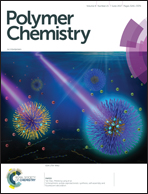Conjugated polymer acceptors based on fused perylene bisimides with a twisted backbone for non-fullerene solar cells†
Abstract
In this work, we present a new strategy to use fused and twisted conjugated backbones to construct conjugated small molecules and polymers as electron acceptors for non-fullerene solar cells. The new conjugated materials containing binary perylene bisimide (PBI) units linked with coplanar thieno[3,2-b]thiophene (as trans-PBI) or twisted thieno[2,3-b]thiophene (as cis-PBI) and the corresponding conjugated polymer cis-polyPBI were developed. A fused conjugated backbone ensures good charge transport, in which the twisted polymer cis-polyPBI was found to show the highest electron mobility of 1.2 × 10−2 cm2 V−1 s−1 in field-effect transistors. Meanwhile, a twisted conjugated backbone effectively prevents the aggregation and crystallization of PBI units, resulting in isotropic charge transport and finely tuned micro-phase separation in bulk-heterojunction thin films. The high electron mobility and isotropic crystallinity make the fused and twisted electron acceptors achieve high power conversion efficiencies above 6% in non-fullerene solar cells, while the coplanar molecule trans-PBI as the electron acceptor shows a very low efficiency of 0.13%.



 Please wait while we load your content...
Please wait while we load your content...